Introduction
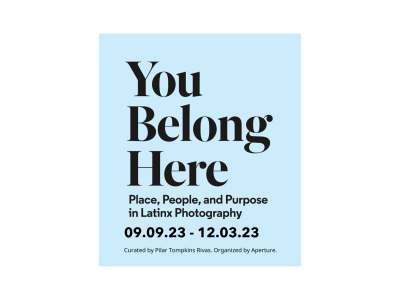
Introductory text in English.
Daisy: You Belong Here: Place, People, and Purpose in Latinx Photography
You Belong Here: Place, People, and Purpose in Latinx Photography celebrates the dynamic photography of Latinx artists across the United States. The exhibition brings together established and emerging artists, who tackle themes of political resistance, family and community, fashion and culture, and the complexity of identity in American life.
Artists in the exhibition contribute to a vast visual archive of the Latinx experience as pluralistic, nuanced, and fluid. They illustrate a range of histories and geographies, contextualize and reinterpret watershed social and artistic movements, stake space for queerness, and articulate the importance of photography within the larger field of Latinx art.
You Belong Here explores contemporary photography that sheds light on social spaces—from intimate portrayals of home and family to collective experiences of the streets and nightlife—as well as the in-betweenness, or nepantla, of transnational, multiracial, and postcolonial identities. It generates an expansive dialogue about visibility and belonging for Latinx people.
Curated by Pilar Tompkins Rivas, chief curator and deputy director of Curatorial and Collections at the Lucas Museum of Narrative Art in Los Angeles, You Belong Here originates from Tompkins Rivas’s work as guest editor of “Latinx,” the Winter 2021 issue of Aperture magazine. This exhibition is organized by Aperture.
Introducción en Español
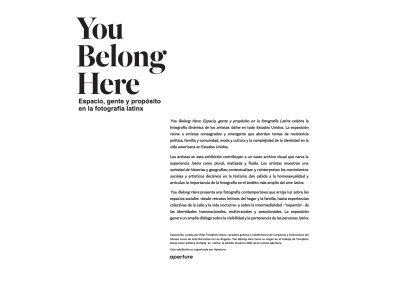
Texto introductorio en Español.
Gui: You Belong Here: Espacio, gente y propósito en la fotografía Latinx celebra la fotografía dinámica de los artistas latinx en todo Estados Unidos. La exposición reúne a artistas consagrados y emergente que abordan temas de resistencia política, familia y comunidad, moda y cultura y la complejidad de la identidad en la vida americana en Estados Unidos.
Los artistas en esta exhibición contribuyen a un vasto archivo visual que narra la experiencia latinx como plural, matizada y fluida. Los artistas muestran una variedad de historias y geografías; contextualizan y reinterpretan los movimientos sociales y artísticos decisivos en la historia; dan cabida a la homosexualidad y articulan la importancia de la fotografía en el ámbito más amplio del arte latinx.
You Belong Here presenta una fotografía contemporánea que arroja luz sobre los espacios sociales -desde retratos íntimos del hogar y la familia, hasta experiencias colectivas de la calle y la vida nocturna- y sobre la intermedialidad -“nepantla”- de las identidades transnacionales, multirraciales y poscoloniales. La exposición genera un amplio diálogo sobre la visibilidad y la pertenencia de las personas latinx.
Exposición curada por Pilar Tompkins Rivas, curadora general y subdirectora de Curaduría y Colecciones del Museo Lucas de Arte Narrativo en Los Ángeles. You Belong Here tiene su origen en el trabajo de Tompkins Rivas como editora invitada en Latinx, la edición Invierno 2021 de la revista Aperture. Esta exhibición es organizada por Aperture.
Hiram Maristany
in English

Hydrant: In the Air, 1963
Digital gelatin silver print
Courtesy of the artist
Daisy: Hiram Maristany, 1945–2022; born and died New York, NY
Hiram Maristany was the son of Puerto Rican migrants. A lifelong East Harlem resident, he photographed underserved New York neighborhoods, forging portraits of resilience, joy, and creative place-making. As a founder and official photo- grapher of the New York chapter of the Young Lords, a Puerto Rican–driven social justice movement, Maristany leveraged photography as part of a media campaign. Following the examples of activists like Martin Luther King Jr., the Black Panthers, and the United Farm Workers, the Young Lords orchestrated spectacular events that attracted news coverage on behalf of the city’s Latinx population.
Rather than create documents of poverty, like the Depression- era photographs of Lewis W. Hine or the Farm Security Administration, Maristany framed his subjects as active participants in building place and community in the face of rampant inequality. If Maristany’s work is driven by the idea that “East Harlem is a beautiful place because of what the people were doing within that space,” it also embraces the more confrontational tactics of the Young Lords and everyday acts of conviviality, improvisation, and creative survival.
Hydrant: In the Air, 1963
Clothing Drive, 1971
Digital gelatin silver prints
Courtesy of the artist
Hiram Maristany
en Español

Hydrant: In the Air, 1963
Impresiones digitales en gelatina de plata
Cortesía del artista
Gui: Hiram Maristany, 1945–2022. Nació y murió en Nueva York, NY
Hiram Maristany fue hijo de inmigrantes puertorriqueños. Residente de East Harlem durante toda su vida, fotografió barrios marginados de Nueva York, concibiendo retratos de resiliencia, alegría y creatividad en la generación de espacios.
Como fundador y fotógrafo oficial de la sección neoyorquina de los Young Lords -un movimiento en pro de la justicia social impulsado por puertorriqueños- Maristany utilizó la fotografía como parte de una campaña mediática. Siguiendo el ejemplo de activistas como Martin Luther King Jr., los Panteras Negras y la Unión de Campesinos, los Young Lords organizaron actos espectaculares que atrajeron la atención de los medios de comunicación en favor de la población latinx de la ciudad.
En vez de documentar la pobreza, como lo hacen las fotografías de Lewis W. Hine o de la entonces Administración de Seguridad Agrícola, de la época de la Depresión, Maristany enmarcó a sus sujetos como participantes activos en la construcción de un espacio y una comunidad frente a la desigualdad generalizada. Si la obra de Maristany está impulsada por la idea de que "East Harlem es un lugar hermoso debido a lo que la gente hacía dentro de ese espacio", también incluye las tácticas más provocadoras de los Young Lords y los cotidianos actos de camaradería, improvisación y supervivencia creativa.
Hydrant: In the Air, 1963
Clothing Drive, 1971
Impresiones digitales en gelatina de plata, cortesía del artista
Perla de Leon
in English
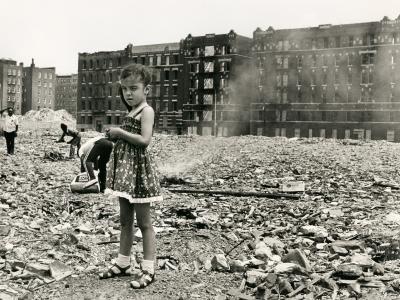
From the series South Bronx Spirit
My Playground, 1981
Archival pigment print
Courtesy of the artist
Daisy: Perla de Leon, Born 1952, New York, NY; active New York
Perla de Leon is a photographer and activist of Puerto Rican descent who was raised in Harlem. Her work examines complex relationships between public policy, economic collapse, and the disenfranchisement of communities of color. In her poignant 1980 series South Bronx Spirit, the artist documents the impact of the construction of the Cross Bronx Expressway on the low-income Black and Brown residents in the neighborhood.
After World War II, urban renewal policies disproportionately affected inner-city populations. The Cross Bronx Expressway, one such initiative, was the first major freeway built through an urban neighborhood. The changes to the South Bronx were devastating, resulting in ruined buildings and streets, a major decline of the area, and a series of fires that destroyed most of the housing in the community.
De Leon’s images focus on the daily lives uprooted by this development, including those of children playing in their decimated neighborhood. Her photographs center on the traces of lost neighborhood life and the children’s spirit and resilience amid their surroundings. In works such as Kung Fu Kick, we see a boy flying high through the air with a karate kick—full of energy, leaping, and soaring. In My Playground, a young girl stares at the camera as a group of kids behind her sort through rubble.
Both works from the series South Bronx Spirit
From top:
My Playground, 1981
Kung Fu Kick, 1980
Archival pigment prints
Courtesy of the artist
Perla de Leon
en Español

De la serie South Bronx Spirit
My Playground, 1981
Impresiones de pigmento de archivo
Cortesía de la artista
Gui: Perla de Leon, n. 1952, New York, NY, Activa en Nueva York
Perla de León es una fotógrafa y activista de ascendencia puertorriqueña y criada en Harlem. Su obra examina las complejas relaciones entre las políticas públicas, el colapso económico y la privación de derechos de las comunidades de color. En su conmovedora serie de 1980 South Bronx Spirit, la artista documenta el impacto que tuvo la construcción de la autopista Cross Bronx en los residentes negros y latinos de bajos ingresos de aquel barrio.
Tras la Segunda Guerra Mundial, las políticas de renovación urbana impactaron desproporcionadamente a las poblaciones de los centros de urbanos. La autopista Cross Bronx, una de esas iniciativas, fue la primera gran autopista construida a través de un barrio urbano. Los cambios en el sur del Bronx fueron devastadores: edificios y calles en ruinas, un deterioro significativo de la zona y una serie de incendios que destruyeron la mayoría de las viviendas de la comunidad.
Las imágenes de De León se enfocan en la cotidianidad de las vidas desarraigadas por la construcción de la autopista, incluidas las vidas de los niños que juegan en su diezmado barrio. Sus fotografías se centran en las trazas de vida de un barrio perdido y en el espíritu y la resiliencia de los niños en torno a su alrededor. En obras como Kung Fu Kick, vemos un niño que vuela por los aires en una patada de karate, lleno de energía, saltando y elevándose. En My Playground, una pequeña niña mira fijamente hacia la cámara mientras que un grupo de niños escudriña los escombros detrás de ella.
Ambas obras de la serie South Bronx Spirit
De izquierda a derecha:
Kung Fu Kick, 1980
My Playground, 1981
Impresiones de pigmento de archivo
cortesía de la artista
Eddie Quiñones
in English
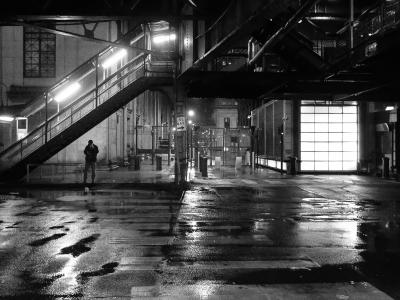
From the series The Onion Field
Lighting Up Under the Chicago L, 2017
Archival pigment print
Courtesy of the artist
Daisy: Eddie Quiñones, Born 1973, Van Wert, OH; active Chicago, IL
Born and raised in Ohio, Eddie Quiñones hails from a Mexican American family with roots in Central and Southeast Texas. His practice addresses relationships between architecture, people, and the urban environment. The Onion Field takes as its subject the city of Chicago, where the artist has lived for more than two decades. The title refers to the Indigenous origins of the name for the city—it may derive from shikaakwa, a word in an Algonquin language that was likely used to describe the wild onions and ramps that grow around the area’s lakes and streams.
Collectively, the images function as a photographic essay doc- umenting daily experiences in relation to the built environment. Quiñones’s high-contrast black-and-white pictures are studies of the play of darkness and light in downtown streets. Lone figures are dominated by the shadows of overhead structures, and ribbons of light denote the scale of the buildings. Through the composition of these street scenes, the artist foregrounds the geometries of space created by the city.
From left:
All works from the series The Onion Field
Passing Through the Light, Chicago, 2013
Under the Overpass, Chicago, 2012
Lighting Up Under the Chicago L, 2017
Archival pigment prints
Courtesy of the artist
Eddie Quiñones
en Español

Todas las obras de la serie The Onion Field
Lighting Up Under the Chicago L, 2017
Impresiones de pigmento de archivo
Cortesía del artista
Gui: Eddie Quiñones, n. 1973, Van Wert, OH, Activo en Chicago, IL
Nacido y criado en Ohio, Eddie Quiñones proviene de una familia mexicoamericana con raíces en el centro y sureste de Texas. Su práctica artística aborda las relaciones entre la arquitectura, las personas y el entorno urbano. La temática de The Onion Field es la ciudad de Chicago, donde el artista ha vivido por más de dos décadas. El título hace referencia a los orígenes indígenas del nombre de la ciudad, que puede que derive de shikaakwa, una palabra en lengua algonquina probablemente utilizada para describir las cebollas y puerros silvestres que crecen alrededor de los lagos y arroyos de la zona.
En conjunto, las imágenes funcionan como un ensayo fotográfico que documenta las experiencias cotidianas en relación con el entorno construido. Las imágenes de Quiñones, en blanco y negro y de alto contraste, son estudios del juego de la oscuridad y la luz en las calles del centro de la ciudad. Las figuras solitarias están dominadas por las sombras de las estructuras elevadas y las franjas de luz denotan la escala de los edificios. A través de la composición de estas escenas callejeras, el artista destaca las geometrías del espacio creadas por la ciudad.
De izquierda a derecha:
Todas las obras de la serie The Onion Field
Passing Through the Light, Chicago, 2013
Under the Overpass, Chicago, 2012
Lighting Up Under the Chicago L, 2017
Impresiones de pigmento de archivo
cortesía del artista
John M. Valadez
in English
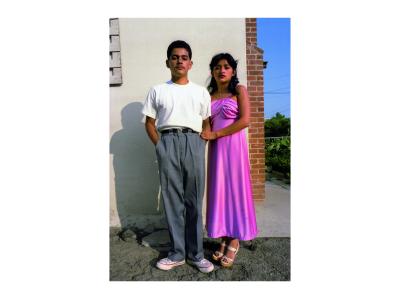
From the East Los Angeles Urban Portrait Portfolio
Couple Balam, ca. 1978
Digital C print on Fujiflex Crystal Archive paper
Courtesy of the artist
Daisy: John M. Valadez, Born 1951, Los Angeles, CA; active Los Angeles
With a career spanning nearly fifty years, John M. Valadez is renowned for painting, pastel drawings, printmaking, murals, and photography. In the 1970s and 1980s, Valadez produced numerous street scenes of downtown and East Los Angeles. His works from this period are largely photorealistic and include cityscapes rich with representations of diverse Angelenos engaged in everyday activities, such as waiting for the bus, selling their wares from storefronts and kiosks, or just passing by. Valadez created photographic portraits of people on the streets that would either stand alone as artworks or inform his paintings and drawings.
These images capture the fashion, personal style, and identity of Chicanx youth of the period. Framing the full figures of the individuals, the tightly cropped photographs document the subjects’ hairstyles, accessories, makeup, hand gestures, and snippets of the background environment to give indications of the neighborhood and its character.
All works from the East Los Angeles Urban Portrait Portfolio
Top row, from left:
Clavo, ca. 1978
Couple Balam, ca. 1978
Alice, ca. 1978
Bottom row, from left:
Two Guys, ca. 1978
Al Gusto, ca. 1978
Brooklyn and Soto, ca. 1978
Digital C prints on Fujiflex Crystal Archive paper
Courtesy of the artist
John M. Valadez
en Español

Todas las obras de East Los Angeles Urban Portrait Portfolio
Couple Balam, ca. 1978
Impresiones digitales C sobre papel de archivo Fujiflex Crystal
Cortesía del artista
Gui: John M. Valadez, n. 1951, Los Ángeles, CA, Activo en Los Ángeles
Con una carrera de casi cincuenta años, John M. Valadez es conocido por su pintura, sus dibujos al pastel, sus grabados, sus murales y su fotografía. En las décadas de 1970 y 1980, Valadez realizó numerosas escenas callejeras del centro y el este de Los Ángeles. Sus obras de este periodo son en gran parte fotorrealistas e incluyen paisajes urbanos ricos en representaciones de angelinos en actividades cotidianas; esperando el autobús, vendiendo sus mercancías en escaparates y quioscos o simplemente pasando por allí. Valadez creó retratos fotográficos de la gente de la calle que, o bien representan obras de arte independientes, o bien han servido de base para sus pinturas y dibujos.
Estas imágenes representan la moda, el estilo personal y la identidad de los jóvenes chicanx de ese periodo. Enmarcando las figuras completas de los individuos, las recortadas fotografías documentan los peinados, accesorios, maquillaje, los movimientos de las manos y fragmentos del ambiente de fondo para dar indicaciones del barrio y su carácter.
Todas las obras de East Los Angeles Urban Portrait Portfolio
Fila superior, de izquierda a derecha:
Clavo, ca. 1978
Couple Balam, ca. 1978
Alice, ca. 1978
Fila inferior, de izquierda a derecha:
Two Guys, ca. 1978
Al Gusto, ca. 1978
Brooklyn and Soto, ca. 1978
Impresiones digitales C sobre papel de archivo Fujiflex Crystal
Cortesía del artista
Guadalupe Rosales
in English
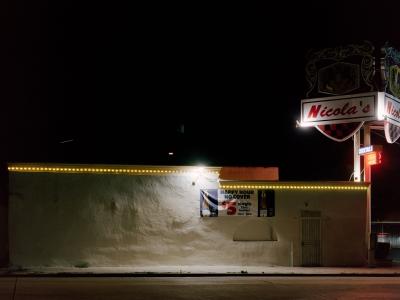
Nicola’s, 2022
Archival pigment print
Courtesy of the artist and Commonwealth and Council, Los Angeles
Daisy: Guadalupe Rosales, Born 1980, Los Angeles, CA; active Los Angeles
Guadalupe Rosales’s practice spans photography, installation, sculpture, digital media, and archives. Her work addresses Latinx youth and subcultures—histories that are not well represented within art, academia, or mainstream media. Through Instagram, the artist has created projects such as Veteranas and Rucas, a virtual space for community-sourced images and commentary, to document and share the lives and experiences of Chicanas in Los Angeles. In her photographs, Rosales draws attention to locations important to her experiences growing up in East Los Angeles. Central to Rosales’s archival work is a deep investigation of the East LA party scene of the 1990s. The artist’s chronicling of this cultural scene includes a physical archive of photographs, party fliers, magazines, clothing, and other ephemera, which Rosales intermingles with images of sculpture, photography, and video on her Instagram account Map Pointz (@map_pointz).
These photographs depict two sites of social interaction: Nicola’s, a gentlemen’s club, and the side door to a movie theater where Rosales and friends would sneak into screenings. The images form part of the artist’s project to capture the city at night and act as a window into memories of her nineties cultural milieu.
From left:
El cine, 2022
Nicola’s, 2022
Archival pigment prints
Courtesy of the artist and Commonwealth and Council, Los Angeles
Guadalupe Rosales
en Español

Nicola’s, 2022
Impresiones de pigmento de archivo
Cortesía de la artista y de la galería Commonwealth and Council, en Los Ángeles
Gui: Guadalupe Rosales, n. 1980, Los Ángeles, CA, Activa en Los Ángeles
La práctica de Guadalupe Rosales abarca la fotografía, la instalación, la escultura, los medios digitales y los archivos. Su trabajo aborda la juventud y las subculturas latinx, historias que no están bien representadas en el arte, la academia ni los medios de comunicación convencionales. A través de Instagram la artista ha creado proyectos como Veteranas y Rucas, un espacio virtual para imágenes y comentarios de la comunidad, con el fin de documentar y compartir las vidas y experiencias de las chicanas en Los Ángeles. En sus fotografías, Rosales atrae la atención hacia lugares significativos durante sus experiencias al crecer en el este de Los Ángeles. El elemento central de la obra de archivo de Rosales es una profunda investigación sobre el escenario de las fiestas del East LA en la década de 1990. La crónica que la artista hace de esta escena cultural incluye un archivo físico de fotografías, folletos de fiestas, revistas, ropa y otros objetos efímeros que Rosales entremezcla con imágenes de escultura, fotografía y vídeo en su cuenta de Instagram Map Pointz (@map_pointz).
Estas fotografías muestran dos lugares de interacción social: El club de caballeros Nicola's y la puerta lateral de un cine donde Rosales y sus amigos se colaban durante las proyecciones. Las imágenes forman parte del proyecto de la artista de capturar la ciudad por la noche y actúan como una ventana a los recuerdos de su entorno cultural de los noventa.
De izquierda a derecha:
El cine, 2022
Nicola’s, 2022
Impresiones de pigmento de archivo
Cortesía de la artista y de la galería Commonwealth and Council, en Los Ángeles
William Camargo
in English
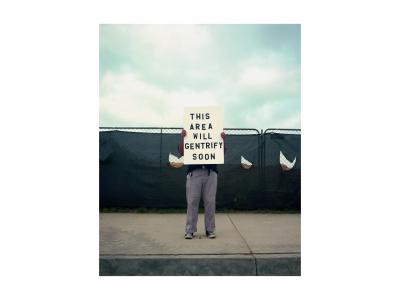
We Gunna Have to Move Out Soon Fam!, Anaheim, 2019
Archival pigment print
Courtesy of the artist
Daisy: William Camargo, Born 1989, Anaheim, CA; active Anaheim
William Camargo’s practice reflects and focuses on Mexican, Chicanx, and Latinx experiences in Orange County,
a part of Southern California predominantly associated with Disneyland, theme parks, and conservative, affluent white residents. His work speaks to hidden labor, land, and racialized histories, drawing attention to the underacknowledged stories of Brown communities in the area. In his images, Camargo is the protagonist, carrying a simple protest sign in public settings that succinctly states the issues and context of a given location.
Among Camargo’s subjects are the legacies of the farming and fruit-packing industries in Orange County, including labor strikes and organizing. He also draws attention to institutionalized racism, including the segregation of public parks and the election of officials active in the Ku Klux Klan to the city councils of Anaheim, Brea, Fullerton, and Orange in the 1920s. In An Attempt to Stop Flipping Houses and We Gunna Have to Move Out Soon Fam!, Anaheim, the artist takes aim at the forces of gentrification within communities of color— documenting himself removing signs that target homeowners for the quick flip of real estate and standing beside the fenced- off perimeter of new construction.
From left:
We Got Everything For You Here, 2020
We Gunna Have to Move Out Soon Fam!, Anaheim, 2019
Yo! There is a Bunch of Brown Folks On This Side!, 2018
An Attempt to Stop Flipping Houses, 2019–ongoing
Archival pigment prints
Courtesy of the artist
William Camargo
en Español

We Gunna Have to Move Out Soon Fam!, Anaheim, 2019
Impresiones de pigmento de archivo
Cortesía de la artista
Gui: William Camargo, n. 1989, Anaheim, CA; Activo en Anaheim
La práctica de William Camargo refleja y se centra en las experiencias mexicanas, chicanx y latinx en el condado de Orange, como parte de una California del Sur principalmente asociada con Disneylandia, los parques temáticos y sus conservadores y acaudalados residentes blancos. Su obra habla de historias ocultas sobre el trabajo, la tierra y los asuntos raciales, atrayendo la atención hacia relatos poco conocidos de las comunidades de pieles marrón de la zona. En sus imágenes, Camargo es el protagonista, portando un sencillo cartel de protesta en espacios públicos que expone de manera sucinta los problemas y el contexto de un lugar determinado.
Entre los temas de Camargo se encuentran los legados de las industrias agrícola y frutícola del condado de Orange, incluidas las huelgas y la organización de los trabajadores. También busca la atención hacia el racismo institucionalizado, como la segregación de los parques públicos y la elección de miembros activos del Ku Klux Klan como funcionarios en los ayuntamientos de Anaheim, Brea, Fullerton y Orange en la década de 1920. En An Attempt to Stop Flipping Houses y We Gunna Have to Move Out Soon Fam!, Anaheim, el artista resalta las fuerzas de la gentrificación dentro de las comunidades de color. Él se documenta a sí mismo retirando carteles dirigidos a los propietarios de viviendas, buscando la especulación del mercado inmobiliario; así como situándose junto al perímetro vallado de las nuevas construcciones.
De izquierda a derecha:
We Got Everything For You Here, 2020
We Gunna Have to Move Out Soon Fam!, Anaheim, 2019
Yo! There is a Bunch of Brown Folks On This Side!, 2018
An Attempt to Stop Flipping Houses, 2019–en curso
Impresiones de pigmento de archivo
Cortesía de la artista
Sofía Córdova
in English

GUILLOTINÆ Wanna Cry, Act Yellow: Break Room, 2019–21
Two-channel video, color, original sound composition; duration: 25 minutes, 29 seconds
Dancers: Alex Cruise, Sofía Córdova, Stephanie Hewett, and Kevin Lo
Audio mixing and mastering: Matthew Gonzalez Kirkland
Courtesy of the artist and Kate Werble Gallery, New York
Daisy: Sofía Córdova, Born 1985, Carolina, Puerto Rico; active Oakland, CA
Córdova’s GUILLOTINÆ Wanna Cry, Act Yellow: Break Room, toggles between the elation of social engagement and the frustration of political isolation. Córdova records herself with three other dancers in a yellow room, juxtaposing their movements against photographs and film footage of revolutionary events.
As Córdova describes the film footage, “Some are bombastic speeches but might unspool into Cuban revolutionaries talking about hardship, about sharing a blanket, smaller voices that speak to collectivity, care, and sharing.” Questioning the iconic status of those considered revolutionary heroes, Córdova often obscures the identities of the figures in the documentary films she shows. For example, in one film, Vladimir Lenin’s head and Fidel Castro’s face are concealed by pixelated squares. In contrast, the four dancers’ faces are exaggerated, made up with stylized emoji expressions. The dancers initially ignore each other to explore the mysterious room—possibly an office break room—before improvising a collective choreography that speaks to the difficulty and energy of mobilizing individuals into politically active masses. “Revolutions are often idealized as rapid and immediate, but, in fact, they may be incredibly tedious; the labor of organizing can be slow,” Córdova notes. “This labor is very hard, messy, and indeterminate. What happens after the first salvo is part of the work that I’m most interested in.”
GUILLOTINÆ Wanna Cry, Act Yellow: Break Room, 2019–21
Two-channel video, color, original sound composition; duration: 25 minutes, 29 seconds
Dancers: Alex Cruise, Sofía Córdova, Stephanie Hewett, and Kevin Lo
Audio mixing and mastering: Matthew Gonzalez Kirkland
Untitled (Rose petals) on small table
Satin, freeze dried petals
Untitled (Playstation buttons), 2021 on shelves
Clay, epoxy, plastic stands
Untitled (Hoop)
Wood, house paint
Courtesy of the artist and Kate Werble Gallery, New York
Sofía Córdova
en Español

GUILLOTINÆ Wanna Cry, Act Yellow: Break Room, 2019–21
Video de dos canales, color, composición sonora original; duración: 25 minutos, 29 segundos.
Bailarines: Alex Cruise, Sofía Córdova, Stephanie Hewett y Kevin Lo
Mezcla de audio y masterización: Matthew González Kirkland
Cortesía de la artista y de la Galería Kate Werble, en Nueva York
Gui: Sofía Córdova, n. 1985, Carolina, Puerto Rico, Activa en Oakland, CA
GUILLOTINÆ Wanna Cry, Act Yellow: Break Room, de Córdova, oscila entre la euforia del compromiso social y la frustración del aislamiento político. Córdova se graba a sí misma con otros tres bailarines en una habitación amarilla, yuxtaponiendo sus movimientos a fotografías y filmaciones de acontecimientos revolucionarios.
Tal como describe Córdova este material fílmico, "algunos son discursos grandilocuentes, pero pueden escindirse en revolucionarios cubanos conversando sobre penurias, sobre compartir una manta; voces más pequeñas que hablan de colectividad, de solidaridad y preocupación". Cuestionando el estatus icónico de los considerados héroes revolucionarios, Córdova a menudo oscurece las identidades de las figuras en los documentales que muestra; por ejemplo, en un corto la cabeza de Vladimir Lenin y la cara de Fidel Castro están ocultas por medio de cuadros pixelados. En contraste, los rostros de los cuatro bailarines son exagerados, hechos con estilizadas expresiones emoji. Al principio, los bailarines se ignoran mutuamente para explorar la misteriosa habitación -posiblemente la sala de descanso de una oficina- antes de improvisar una coreografía colectiva que habla de la dificultad y la energía de movilizar a los individuos en masas políticamente activas. "Las revoluciones suelen idealizarse como rápidas e inmediatas, pero puede que en realidad sean increíblemente tediosas; la labor de organización puede ser lenta", señala Córdova. "Esta labor es muy dura, desordenada e indeterminada. Lo que ocurre después de la primera descarga forma parte del trabajo que más me interesa".
GUILLOTINÆ Wanna Cry, Act Yellow: Break Room, 2019–21
Video de dos canales, color, composición sonora original; duración: 25 minutos, 29 segundos.
Bailarines: Alex Cruise, Sofía Córdova, Stephanie Hewett y Kevin Lo
Mezcla de audio y masterización: Matthew González Kirkland
Sin título (pétalos de rosa) sobre mesa pequeña
Satén, pétalos liofilizados
Sin título (botones de Playstation), 2021 sobre estante
Arcilla, epoxi, soporte de plástico
Sin título (Argolla)
Madera, pintura para casas
Cortesía de la artista y de la Galería Kate Werble, en Nueva York
Gabriela Ruiz & Bibs Moreno
in English
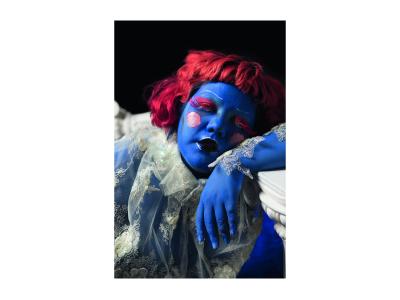
Untitled, October 2017
Archival pigment print
Courtesy of Bibs Moreno
Daisy:
Gabriela Ruiz, Born 1991, San Fernando Valley, CA; active Los Angeles, CA
Bibs Moreno, Born 1992, Anaheim, CA; active Los Angeles, CA
Growing up in Los Angeles’s San Fernando Valley with Mexican immigrant parents, Gabriela Ruiz absorbed what she calls a “DIY work ethic,” which permeates her multimedia, performance-based practice and her elaborate costuming. Fashion was once a defense mechanism for the artist, a way to guard against bullies. In 2014 she started Leather Papi, a clothing brand that unabashedly embraces kink culture. Sex oozes from many of her works as a rebellion against society’s restrictive beauty standards and a commitment to exploring the taboo.
Ruiz has collaborated with the photographer Bibs Moreno for about seven years, since she responded, on a whim, to Moreno’s search for people to photograph. A 2017 photograph by Moreno shows Ruiz painted bright blue, eyes half-open, leaning against a classical column. Moreno has photographed Ruiz in green spaces, on city streets, in off-the-cuff poses at a party, and in anachronistic black and white for a luminous portrait titled Cleansed that feels plucked from the 1920s. “She takes the best photographs of me, I’d say,” Ruiz effuses. Their friendship and comfort with each other are apparent in their portraits.
From left:
Untitled, April 2018
Untitled, October 2017
Cleansed, November 2016
Untitled, April 2017
Billow, 2021
NYE, December 2017
Archival pigment prints
Courtesy of Bibs Moreno
Gabriela Ruiz & Bibs Moreno
en Español

Sin título, octubre de 2017
Impresiones de pigmento de archivo
Cortesía de Bibs Moreno
Gui:
Gabriela Ruiz, n. 1991, Valle de San Fernando, CA, Activa en Los Ángeles, CA
Bibs Moreno, n. 1992, Anaheim, CA, Activa en Los Ángeles, CA
De padres inmigrantes mexicanos, Gabriela Ruiz creció en el Valle de San Fernando, en Los Ángeles y absorbió lo que ella denomina una "ética de trabajo de bricolaje" que impregna su práctica artística multimedia y basada en el arte del performance y su elaborado vestuario. La moda fue para la artista un mecanismo de defensa, una forma de protegerse contra el bullying. En el 2014 la artista fundó Leather Papi, una marca de ropa que abraza sin complejos la cultura kink. El sexo transpira en muchas de sus obras como una rebelión contra los restrictivos cánones de belleza de la sociedad y un compromiso con la exploración del tabú.
Ruiz ha colaborado con la fotógrafa Bibs Moreno desde que por capricho respondió a la búsqueda de Moreno por personas a quién fotografiar, hace alrededor de siete años. Una fotografía de Moreno del 2017 muestra a Ruiz pintada de azul brillante, con los ojos entreabiertos, apoyada en una columna clásica. Moreno ha fotografiado a Ruiz en espacios verdes, en las calles de la ciudad, en poses casuales durante una fiesta y en un anacrónico blanco y negro para un luminoso retrato titulado Cleansed que parece sacado de los años veinte. "Diría que me hace las mejores fotos", se regocija Ruiz. La amistad y la comodidad que existe entre ellas se aprecia en sus retratos.
De izquierda a derecha:
Sin título, abril de 2018
Sin título, octubre de 2017
Cleansed, noviembre de 2016
Sin título, abril de 2017
Billow, 2021
NYE, diciembre de 2017
Impresiones de pigmento de archivo
Cortesía de Bibs Moreno
Reynaldo Rivera
in English
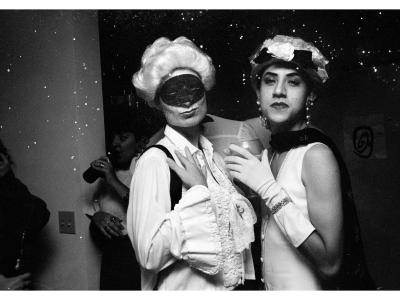
Elyse Regehr and Javier Orosco, Downtown LA, 1989
Digital print from negative
Courtesy of the artist and Reena Spaulings Fine Art, New York / Los Angeles
Daisy: Reynaldo Rivera, Born 1964, Mexicali, Mexico; active Los Angeles, CA
Reynaldo Rivera bounced between cities on both sides of the US-Mexico border throughout his childhood. He has taken photographs for most of his life, primarily in and around Los Angeles and on his travels in Mexico, Europe, and Central and South America. He documents the sun-cracked landscapes and the women who cleaned the cheap SRO hotel rooms he rented in Stockton, California, where, as a teen, he worked seasonally in a Campbell’s Soup cannery to support his picture-taking and glam thrift habit.
His photographs also interpret various facets of the word “scene”—the East LA scene, the drag scene, the queer scene, the punk scene, the art scene—and impressions of a greater scene created by the mix of genders, classes, and orientations milling about the house parties, drag bars, music shows, and bathrooms. Rivera recalls, “When I was working in Stockton, there was this big used bookstore. The Filipino lady that worked there really liked me. She would let me take boxes of books for like three dollars. I would devour old photo magazines and old movie-star magazines because I had nothing else to do. That was my education.”
From left:
Elyse Regehr and Javier Orosco, Downtown LA, 1989
Little Joy Jr. Bar, Los Angeles, 1997
Gaby, Reynaldo, and Angela, La Plaza, 1993
La Plaza, 1997
Digital prints from negatives
Courtesy of the artist and Reena Spaulings Fine Art, New York / Los Angeles
Reynaldo Rivera
en Español

Elyse Regehr and Javier Orosco, Downtown LA, 1989
Impresiones digitales a partir de negativos
Cortesía del artista y de Reena Spaulings Fine Art, Nueva York / Los Ángeles
Gui: Reynaldo Rivera, n. 1964, Mexicali, México, Activo en Los Ángeles, CA
Reynaldo Rivera vivió su infancia oscilando entre ciudades a ambos lados de la frontera México-Estados Unidos. Lleva casi toda su vida haciendo fotografía, principalmente en Los Ángeles y sus alrededores y en sus viajes por México, Europa, Centro y Sudamérica. Reynaldo ha documentado paisajes resquebrajados por el sol y también a mujeres que limpiaban las habitaciones individuales de los hoteles baratos que alquilaba en Stockton, California, donde en su adolescencia trabajó por temporadas en una fábrica de conservas de sopa Campbell’ s para mantener su afición a la fotografía y al glamur de segunda mano.
Sus fotografías interpretan varias facetas de la palabra “escena” -la escena de East LA, la escena drag, la queer, la punk, la escena artística- e impresiones de una escena más grande creada por la mezcla de géneros, clases y orientaciones, remolinándose en las fiestas caseras, en los bares drag, en los espectáculos musicales y en los baños. Rivera recuerda: “Cuando trabajaba en Stockton había una tienda de libros usados y la señora filipina que trabajaba ahí realmente me quería. Me dejaba llevarme cajas de libros por unos tres dólares. Yo devoraba las viejas revistas de fotografía y de estrellas de cine porque no tenía nada más que hacer. Esa fue mi educación”.
De izquierda a derecha:
Elyse Regehr and Javier Orosco, Downtown LA, 1989
Little Joy Jr. Bar, Los Angeles, 1997
Gaby, Reynaldo, and Angela, La Plaza, 1993
La Plaza, 1997
Impresiones digitales a partir de negativos
Cortesía del artista y de Reena Spaulings Fine Art, Nueva York / Los Ángeles
Tarrah Krajnak
in English
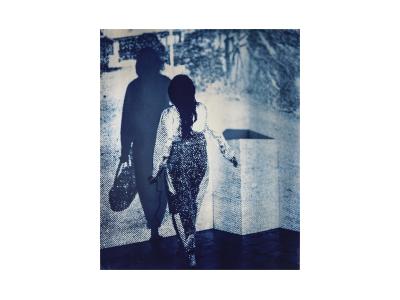
From the series 1979: Contact Negatives, 2019
Cyanotypes
Courtesy of the artist and Galerie Thomas Zander, Cologne
Daisy: Tarrah Krajnak, Born 1979, Lima, Peru; active Los Angeles, CA, and Eugene, OR
Tarrah Krajnak’s photographs first appeared in the exhibition and handmade zine 1979: Contact Negatives, created in 2019. In the title, 1979 refers to the year Krajnak was born, adopted from an orphanage in Lima, Peru, and moved to North America. The work grew out of an intense search the artist conducted in Lima’s markets and basements for printed matter from the time of her birth, a turbulent political period between two coups. In a Los Angeles gallery, she photographed herself among these found images—crowd scenes, architecture, erotica—projected on the walls of the white gallery.
A recurring motif in these images is a white pedestal the height and width of Krajnak’s own body. In some images, she uses it to sit or hide; in others, she holds it, as if catching the pedestal as it falls. Is it a ghost? A false body? Krajnak asks: What does it mean to be born of a violent act you cannot verify, to be haunted by a life you have not lived? In her work, she turns these questions into dreamscapes shaped by the debris of collective memory.
All works from the series:
1979: Contact Negatives, 2019
Cyanotypes
Courtesy of the artist and Galerie Thomas Zander, Cologne
Tarrah Krajnak
en Español

1979: Contact Negatives, 2019
Cianotipos
Cortesía de la artista y de la Galería Thomas Zander, Colonia, Alemania
Gui: Tarrah Krajnak, n. 1979, Lima, Perú, Activa en Los Ángeles, CA y en Eugene, OR
Las fotografías de Tarrah Krajnak aparecieron por primera vez en la exposición y fanzine artesanal 1979: Contact Negatives, creada en el año 2019. En el título, 1979 hace referencia al año en que Krajnak nació, fue adoptada de un orfanato en Lima, Perú y trasladada a Norteamérica. La obra surgió de una intensa búsqueda que la artista llevó a cabo en los mercados y sótanos de Lima en busca de material impreso de la época de su nacimiento, un turbulento periodo político entre dos golpes de Estado. En una galería de Los Ángeles se fotografió a sí misma entre estas imágenes encontradas -escenas de multitudes, arquitectura, arte erótico- y proyectadas en las paredes blancas de la galería.
Un motivo recurrente en estas imágenes es un pedestal blanco de la altura y ancho del propio cuerpo de Krajnak. En algunas imágenes lo utiliza para sentarse o esconderse; en otras, lo sostiene, como si atrapara el pedestal al caer. ¿Es un fantasma? ¿Un cuerpo falso? Krajnak se pregunta: ¿Qué significa nacer de un acto violento que no puedes verificar, ser atormentada por una vida que no has vivido? En su obra convierte estas preguntas en paisajes oníricos delineados por los restos de la memoria colectiva.
Todas las obras de la serie:
1979: Contact Negatives, 2019
Cianotipos
Cortesía de la artista y de la Galería Thomas Zander, Colonia, Alemania
Joiri Minaya
in English
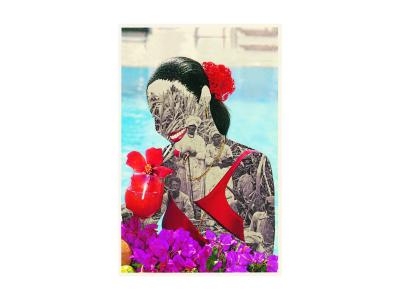
The Upkeepers, 2021
Archival pigment print
Courtesy of the artist
Daisy: Joiri Minaya, Born 1990, New York, NY; active New York
Joiri Minaya, born in New York and raised in the Dominican Republic, is a multidisciplinary artist whose work investigates the body within constructions of gender, identity, social space, and landscape to complicate hierarchies and challenge “otherness.” Minaya created Woman-landscape (On Opacity) #4 and #5 as part of a series in which she collages vintage postcards advertising the Dominican Republic. She super- imposes samples of commercially available “tropical prints” and archival images within her photographs to obscure an easy understanding of the landscape. In Continuum II, she juxtaposes a well-known painting by the Canadian artist François Beaucourt—formerly known as Portrait of a Negro Slave (1786; McCord Stewart Museum) and recently retitled Portrait of a Haitian Woman—with an image of a brochure of Bávaro, a tourist town in the eastern Dominican Republic.
Minaya speaks about expanding “identity labels” when making and discussing her work. She is interested in subverting the assumptions and expectations people make when they identify her as Caribbean or Dominican. Minaya reclaims representations of the Dominican landscape and critiques the colonial gaze, revealing the breadth and depth of the worlds she depicts.
From left:
Siboney, 2014
Video, Courtesy of the artist
Continuum II, 2021
Woman-landscape (On Opacity) #4, 2020
Woman-landscape (On Opacity) #5, 2020
Ayoowiri / Girl with poinciana flowers, 2020
The Upkeepers, 2021
Archival pigment prints
Courtesy of the artist
Joiri Minaya
en Español

The Upkeepers, 2021
Impresiones de pigmento de archivo
Cortesía de la artista
Gui: Joiri Minaya, n. 1990, Nueva York, NY, Activa en New York
Joiri Minaya, nació en Nueva York y se crio en República Dominicana. Una artista multidisciplinaria cuyo trabajo explora el cuerpo en el sentido de la construcción del género, la identidad, el espacio social y el entorno, complicando las jerarquías y desafiando la “otredad”. Minaya creó Woman-landscape (On Opacity) #4 y #5 como parte de una serie en la que hace un collage de antiguas postales con propaganda de la República Dominicana. Ella superpone muestras de "estampas tropicales" comerciales e imágenes de archivo dentro de sus fotografías para desdibujar una fácil comprensión del paisaje. En Continuum II yuxtapone una conocida pintura del artista canadiense François Beaucourt—antes titulada Retrato de una esclava negra (1786; Museo McCord Stewart) y recientemente retitulada Retrato de una Mujer Haitiana— con la imagen de un folleto de Bávaro, ciudad turística al este de la República Dominicana.
Al hacer y conversar respecto de su obra Minaya habla sobre la ampliación de las "etiquetas de identidad”. A ella le interesa menoscabar las suposiciones y expectativas que la gente hace cuando la identifican como caribeña o dominicana. Minaya reivindica las representaciones del paisaje dominicano y critica la mirada colonial, revelando la amplitud y profundidad de los mundos que retrata.
De izquierda a derecha:
Continuum II, 2021
Woman-landscape (On Opacity) #4, 2020
Woman-landscape (On Opacity) #5, 2020
Ayoowiri / Girl with poinciana flowers, 2020
The Upkeepers, 2021
Impresiones de pigmento de archivo
Cortesía de la artista
Siboney, 2014
Video, cortesía de la artísta
Laura Aguilar
Plush Pony series in English

Plush Pony, 1992
Gelatin silver print
Courtesy of Los Angeles County Museum of Art, Gift of the Laura Aguilar Trust of 2016, jointly acquired by the Los Angeles County Museum of Art and the Vincent Price Art Museum Foundation.
Daisy: Laura Aguilar, 1959-2018, born San Gabriel, CA; died Long Beach, CA
Laura Aguilar, the late Chicana photographer, grounded herself and her art in the natural landscapes she knew so intimately in order to express her difficult truths. As a lesbian who was fat bodied and struggling with a learning disability, she insisted on finding her way despite the sexism, homophobia, and racism that would otherwise erase her altogether. Yet despite these obstacles, Aguilar’s vulnerability and persistent honesty allowed her to give view to her own life as well as the complex lives of queer people of color in LA’s Eastside and beyond.
In much of her work, Aguilar pushed beyond the boundaries of her own comfort, driven by genuine curiosity and a spirit of inquiry. As an artist, she sought to master the craft of photography and was known for her insistence on technical perfection while also using the medium to delve into complicated questions of identity and belonging. She challenged herself to venture beyond her own circles of friends and acquaintances to photograph bar goers at an Eastside, working-class lesbian bar called the Plush Pony. Despite her own ambivalence as an outsider, she captured the venue and its patrons’ joyous yet guarded spirit.
From left:
Plush Pony #15, 1992
Plush Pony, 1992
Plush Pony, 1992
Gelatin silver prints
Courtesy of Los Angeles County Museum of Art, Gift of the Laura Aguilar Trust of 2016, jointly acquired by the Los Angeles County Museum of Art and the Vincent Price Art Museum Foundation.
Laura Aguilar
Plush Pony en Español

Plush Pony, 1992
Impresiones en gelatina de plata
Cortesía del museo de arte Los Angeles County, obsequio del fondo Laura Aguilar del 2016, adquirido en conjunto por el museo de arte Los Angeles County y la fundación Museo de Arte Vincent Price.
Gui: Laura Aguilar, 1959–2018, nació San Gabriel, CA; murió en Long Beach, CA
La fotógrafa chicana fallecida Laura Aguilar, volcó su persona y su arte en los paisajes naturales que conocía tan íntimamente, para expresar sus difíciles verdades. Lesbiana, obesa y luchando con una discapacidad de aprendizaje, insistió en encontrar su camino a pesar del sexismo, la homofobia y el racismo que, de otro modo, la habrían suprimido por completo. Sin embargo, a pesar de estos obstáculos, la vulnerabilidad y la persistente honestidad de Aguilar le permitieron dar una visión de su propia vida y de las vidas complejas de las personas queer de color en el East LA y más allá.
En gran parte de su obra Aguilar rebasó los límites de su propia comodidad, impulsada por una curiosidad genuina y un espíritu indagatorio. Como artista, buscó dominar el oficio de la fotografía y fue conocida por su insistencia en la perfección técnica, a la vez que utilizaba este medio para profundizar en complicadas cuestiones de identidad y pertenencia. Se retó a sí misma a aventurarse más allá de sus círculos de amigos y conocidos para fotografiar a los clientes de un bar de lesbianas de clase trabajadora, llamado Plush Pony, en el lado este de LA. A pesar de su propia ambivalencia como intrusa, captó el local y el espíritu alegre pero reservado de los clientes.
De izquierda a derecha:
Plush Pony #15, 1992
Plush Pony, 1992
Plush Pony, 1992
Impresiones en gelatina de plata
Cortesía del museo de arte Los Angeles County, obsequio del fondo Laura Aguilar del 2016, adquirido en conjunto por el museo de arte Los Angeles County y la fundación Museo de Arte Vincent Price.
Laura Aguilar
Stillness series in English

Stillness #25, 1999
Gelatin silver print
Courtesy of Los Angeles County Museum of Art, Gift of the Laura Aguilar Trust of 2016, jointly acquired by the Los Angeles County Museum of Art and the Vincent Price Art Museum Foundation.
Daisy: Laura Aguilar, 1959-2018, born San Gabriel, CA; died Long Beach, CA
By the mid-1990s, Aguilar’s nude self-portraits in nature give witness to her arrival at a way of being at home—with both her body and her historical lineage—through a strong connection to the land. In her Nature Self-Portraits (1996) and Stillness(1999) series, she positions herself as an integral part of an ecosystem. Often posing by herself, or with other women, Aguilar reasserts her body, its shape and size, setting it in the context of the desert landscape as a way to belong to a natural and historical place. She affirms her personal and multigenerational relationship to California and collective narratives of the colonized West.
From top:
Stillness #25, 1999
Stillness #26, 1999
Gelatin silver prints
Courtesy of Los Angeles County Museum of Art, Gift of the Laura Aguilar Trust of 2016, jointly acquired by the Los Angeles County Museum of Art and the Vincent Price Art Museum Foundation.
At right:
Three Eagles Flying, 1990
Gelatin silver prints
Courtesy of Los Angeles County Museum of Art, jointly acquired by the Los Angeles County Museum of Art, with funds provided by Frank Masi and Donna Kolb and the Ralph M. Parsons Fund, and the Vincent Price Art Museum Foundation, with funds provided by the Foundation and the Newton Family.
Laura Aguilar
Stillness en Español

Stillness #25, 1999
Impresiones en gelatina de plata
Cortesía del museo de arte Los Angeles County, obsequio del fondo Laura Aguilar del 2016, adquirido en conjunto por el museo de arte Los Angeles County y por la fundación Museo de Arte Vincent Price.
Gui: Laura Aguilar, 1959–2018, nació San Gabriel, CA; murió en Long Beach, CA
A mediados de la década de 1990, los autorretratos de Aguilar, desnuda en la naturaleza, dan testimonio de su llegada a una forma de sentirse en casa, tanto con su cuerpo como con su linaje histórico, a través de una fuerte conexión con la tierra. En sus series Nature Self-Portraits (1996) y Stillness (1999),
la artista se sitúa como parte integral de un ecosistema. A menudo posando sola o con otras mujeres, Aguilar reafirma
su cuerpo, su forma y tamaño, situándolo en el contexto del paisaje desértico como una manera de pertenecer a un lugar natural e histórico. Ella consolida su relación personal y multigeneracional con California y con las narrativas colectivas del Oeste colonizado.
De arriba abajo:
Stillness #25, 1999
Stillness #26, 1999
Impresiones en gelatina de plata
Cortesía del museo de arte Los Angeles County, obsequio del fondo Laura Aguilar del 2016, adquirido en conjunto por el museo de arte Los Angeles County y por la fundación Museo de Arte Vincent Price.
A la derecha:
Three Eagles Flying, 1990
Impresiones en gelatina de plata
Cortesía del museo de arte Los Angeles County, adquirido en conjunto por el museo de arte Los Angeles County con fondos otorgados por Frank Masi y Donna Kolb, y el fondo Ralph M. Parsons; y la fundación Museo de Arte Vincent Price, con fondos otorgados por la fundación y la familia Newton.
Steven Molina Contreras
in English
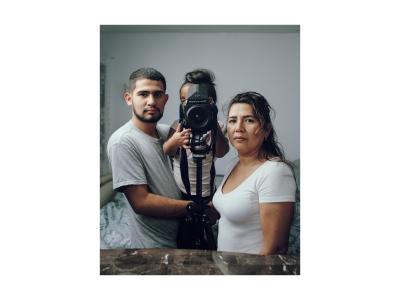
Abigail’s Portrait, United States, 2019
Archival pigment print
Courtesy of the artist
Daisy: Steven Molina Contreras, Born 1999, San Salvador, El Salvador; active New York, NY
The work of Steven Molina Contreras centers on the intimacy of home through images that capture unspoken moments between family members. In the series Adelante, the photog- rapher chronicles his mother, father, stepfather, grandparents, and sisters with both pride and sensitivity. Shot in New York and El Salvador, the images unite a family separated across time and place and on either side of a story of immigration. Molina Contreras’s work speaks to intergenerational relationships and the split between two countries.
Unlike many documentary photographers of migrants who focus on the lives and experiences of men, Molina Contreras pays particular attention to the strength and endurance of women. Matriarchy is important to the artist. We see the exaltation of generations of sacrifice in Mujeres Celestiales, a portrait of his older sister, younger sister, mother, and grandmother. The women sit on a white bed with a frilly white frame against a white wall, daring the viewer, or anybody, to divide them again. These photographs are made with patience and taken as part of an ongoing collection of images of family, borders, possessions, and belonging.
From left:
All works from the series Adelante
Mother Alma #3, She’ll hold you for a lifetime, United States, 2019
Mujeres Celestiales (Celestial women), United States, 2021
Abigail’s Portrait, United States, 2019
To have and to hold, Tío y Tía (Uncle and aunt), El Salvador, 2021
Las Flores de mi Abuelita Carmen (My Grandma Carmen’s flowers), El Salvador, 2019
Archival pigment prints
Courtesy of the artist
Steven Molina Contreras
en Español

Abigail’s Portrait, Estados Unidos, 2019
Impresiones de pigmento de archivo
Cortesía de la artista
Gui: Steven Molina Contreras, n. 1999, San Salvador, El Salvador, Activo en Nueva York, NY
La obra de Steven Molina Contreras se centra en la intimidad del hogar a través de imágenes que capturan momentos tácitos entre los miembros de una familia. En la serie Adelante, el fotógrafo muestra con orgullo y sensibilidad una narrativa sobre su madre, su padre, su padrastro, sus abuelos y su hermana. Las imágenes, capturadas en Nueva York y El Salvador, unen a una familia separada por el tiempo y el espacio y a ambos lados de una historia de inmigración. El trabajo de Molina Contreras habla sobre las relaciones intergeneracionales y la división entre dos países.
A diferencia de muchos fotógrafos documentalistas de migrantes quienes se enfocan en las vidas y experiencias de los hombres, Molina Contreras presta especial atención a la fuerza y resistencia de las mujeres. El matriarcado es importante para el artista. Vemos la exaltación de generaciones de sacrificio en Mujeres Celestiales; un retrato de sus hermanas -la mayor y la menor-, su madre y su abuela. Las mujeres sentadas en una cama blanca, con cabecera blanca de estilo recargado, contra una pared igualmente blanca, desafiando al espectador o a cualquiera, a dividirlas de nuevo. Estas fotografías son elaboradas con paciencia y tomadas como parte de una recopilación continua de imágenes de la familia, las fronteras, las posesiones y la pertenencia.
De izquierda a derecha:
Todas las obras de la serie Adelante
Mother Alma #3, She’ll hold you for a lifetime, Estados Unidos, 2019
Mujeres Celestiales (Celestial women), Estados Unidos, 2021
Abigail’s Portrait, Estados Unidos, 2019
To have and to hold, Tío y Tía (Uncle and aunt), El Salvador, 2021
Las Flores de mi Abuelita Carmen (My Grandma Carmen’s flowers), El Salvador, 2019
Impresiones de pigmento de archivo
Cortesía de la artista
Star Montana
in English
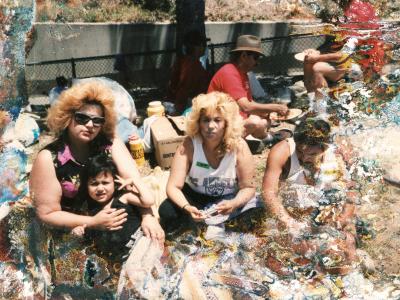
Louisa, Cathy, and Little Star, 2019
Archival pigment print
Courtesy of the artist
Daisy: Star Montana, Born 1987, Los Angeles, CA; active Los Angeles
Star Montana, who grew up in the East Los Angeles neighborhood of Boyle Heights, invites friends and family to share scenes from their homes and neighborhoods. Boyle Heights has a long history of multiethnic activism and cultural richness despite widespread poverty, discrimination, violence, and gentrification. In her photographs, Montana features her own family’s experiences of loss and intergenerational trauma. Water damage gnaws at the edges of rescued family photographs and disfigures the images of her loved ones—as well as those of strangers and lovers who vanished from her life as quickly as they appeared. “I wanted to keep the water damage. These are the ruins of diaspora,” she says.
Montana associates trauma with her family’s journey from El Paso, Texas, to Los Angeles following the death of one of her grandmothers. “Our line was cut. It was the end of our connection to El Paso.” Montana’s work sits patiently in the grief of displacement—the aching loss of connection to homeland and the unraveling fabric of family.
From left:
Destroyed Little Star, 2018
Family Portrait, 2019
Louisa and Lover, 1980s, 2019
Louisa and Star, 1990s, 2019
Louisa, Cathy, and Little Star, 2019
Paula’s Desk, 2014
Star in the Dark, 2014
Archival pigment prints
Courtesy of the artist
Sunset (at the End of the Chihuahuan Desert), 2018
Vinyl mural, Courtesy of the artist
Star Montana
en Español

Louisa, Cathy, and Little Star, 2019
Impresiones de pigmento de archivo
Cortesía de la artista
Gui: Star Montana, n. 1987, Los Ángeles, CA, Activa en Los Ángeles
Star Montana -quien creció en el barrio de Boyle Heights, al este de Los Ángeles- invita a amigos y familiares a compartir escenas de sus hogares y sus barrios. Boyle Heights tiene una larga historia de activismo multiétnico y riqueza cultural a pesar de la pobreza generalizada, la discriminación, la violencia y la gentrificación. En sus fotografías Montana muestra las experiencias de la pérdida y el trauma intergeneracional de su propia familia. Los daños causados por el agua carcomen los bordes de las rescatadas fotografías familiares, desfigurando las imágenes de sus seres queridos y las de los extraños y amantes que desaparecieron de su vida tan pronto como llegaron. “Quiero conservar los daños causados por el agua; son las ruinas de la diáspora” añade la autora.
En sus fotografías Montana asocia el trauma con el viaje de su familia desde El Paso, Texas, a Los Ángeles tras la muerte de una de sus abuelas. "Nuestro eje se rompió. Fue el fin de nuestra conexión con El Paso". La obra de Montana se asienta pacientemente en el dolor del desplazamiento, la dolorosa pérdida de la conexión con la patria y del tejido familiar que se deshace.
De izquierda a derecha:
Destroyed Little Star, 2018
Family Portrait, 2019
Louisa and Lover, 1980s, 2019
Louisa and Star, 1990s, 2019
Louisa, Cathy, and Little Star, 2019
Paula’s Desk, 2014
Star in the Dark, 2014
Impresiones de pigmento de archivo
Cortesía de la artista
Genesis Báez
in English
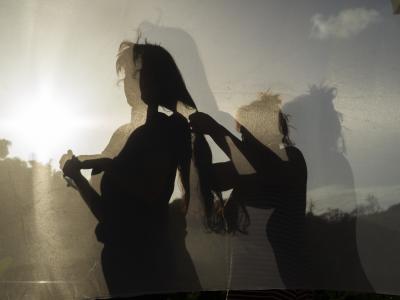
Parting (Braid), 2021
Archival pigment print
Courtesy of the artist
Daisy: Genesis Báez, Born 1990, Attleboro, MA; active New York, NY
Genesis Báez was born to Puerto Rican parents who migrated to New England to work in factories. After her mother and grandmother took her to Puerto Rico for the first time, she developed a relationship with the island. “In a sense,” she says, “I inherited Puerto Rico and a connection to a homeland through the women in my family.”
That all Báez’s subjects are women is intentional. By focusing on the hand gestures of her subjects, Báez explores the complexity of care, touch, and belonging among the diasporic communities of Puerto Rican women in her home in the northeastern United States and beyond. “I like to think about how gesture and touch can conjure a sense of belonging when one’s attachment to a place has been disrupted by migration, colonial legacies, and climate change,” she says. Báez gives little indication of geographic context; however, clues occasionally appear in the frame—like a winter coat or the roots of a ceiba tree. She offers instead a universal interpretation of migration, cyclical movements, and transient connections.
From left:
The Sound of a Circle, 2018
Condensation (San Juan Airport), 2019
Pull (The Weight of Two Suns), 2018
Parting (Braid), 2021
Shadow Loop, 2020
Return (Tania After Moving Back, With Sky Colored Nails), San Juan, 2021
Archival pigment prints
Courtesy of the artist
Genesis Báez
en Español

Parting (Braid), 2021
Impresiones de pigmento de archivo
Cortesía de la artista
Gui: Genesis Báez, n. 1990, Attleboro, MA, Activa en Nueva York, NY
Genesis Báez nació de padres puertorriqueños que migraron a Nueva Inglaterra para trabajar en las fábricas. Después de que su madre y su abuela la llevaron a Puerto Rico por primera vez, ella desarrolló una fuerte relación con la isla. "En cierto sentido -dice la autora-, a través de las mujeres de mi familia heredé Puerto Rico y la conexión con una patria".
El hecho de que todos los sujetos del arte de Báez sean mujeres es intencionado; al centrarse en los gestos de sus manos, Báez explora la complejidad del cuidado, el tacto y la pertenencia entre las comunidades desplazadas de mujeres puertorriqueñas al noreste de Estados Unidos -su hogar- y más allá.
“Me gusta pensar que los gestos y el tacto pueden invocar un sentido de pertenencia cuando se ha perturbado el apego a un lugar debido a la migración, la herencia colonial y el cambio climático” - dice la autora. Báez da pocas indicaciones sobre el contexto geográfico; sin embargo, de vez en cuando aparecen pistas en el encuadre, como un abrigo de invierno o las raíces de una ceiba. En su lugar, ofrece una interpretación universal de la migración, los movimientos cíclicos y las conexiones transitorias.
De izquierda a derecha:
The Sound of a Circle, 2018
Condensation (San Juan Airport), 2019
Pull (The Weight of Two Suns), 2018
Parting (Braid), 2021
Shadow Loop, 2020
Return (Tania After Moving Back, With Sky Colored Nails), San Juan, 2021
Impresiones de pigmento de archivo cortesía de la artista




